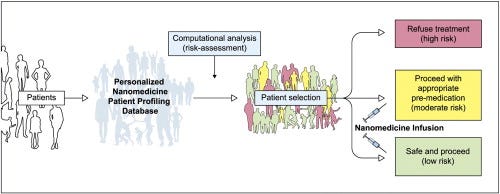Neuro, broncho-pulmonary, cardiovascular ADVERSE effects of NANOPHARMACEUTICALS (aka MRNA)
Theme: it hurts
I found this article which reviewed the adverse of effects of Nano-medicines. This compendium of adverse effects from administration of nanopharmaceuticals by researchers, is eerily similar the the growing list of adverse effects we are seeing with the administration the the nano-pharmaceutical mRNA technology. Who makes the links. Who makes the links.
Genomic perspectives in inter-individual adverse responses following nanomedicine administration: The way forward
S Moein Moghimi 1, Peter P Wibroe, Shen Y Helvig, Z Shadi Farhangrazi, A Christy Hunter
Affiliations expand
PMID: 22634158
Abstract
The underlying mechanism of intravenous infusion-related adverse reactions inherent to regulatory-approved nanomedicines still remains elusive. There are substantial inter-individual differences in observed adverse reactions, which may include cardiovascular, broncho-pulmonary, muco-cutaneous, neuro-psychosomatic and autonomic manifestations. Although nanomedicine-mediated triggering of complement activation has been suggested to be a significant contributing factor to these adverse events, complement activation may still proceed in non-responders.
Whether these reactions share similar immunological mechanisms and underpinning genetic factors with drug hypersensitivity syndrome remains to be investigated. Genetic association studies could be a powerful tool to dissect causative factors and reveal the multiple molecular pathways that induce infusion related adverse reactions.
It is envisaged that such research may lead to the design of reliable in vitro profiling tests for risk assessment and treatment decisions, thereby revolutionizing the practice of medicine with nanopharmaceuticals.
Such procedures may further improve regulatory approval processes for nanomedicines currently in the pipeline and decrease the overall cost of health care. Here we discuss some key innate immunity genes and their polymorphisms in relation to nanomedicine infusion-mediated symptomatic responses.
Graphical abstract
Introduction
Intravenous infusion of therapeutic liposomes (e.g., Doxil®), micellar formulations (e.g., Taxol®), contrast agents and monoclonal antibodies in humans (and experimental animals such as pigs, dogs, sheep) may trigger acute allergic-like adverse reactions with cardiovascular, broncho-pulmonary, muco-cutaneous, neuro-psychosomatic and autonomic manifestations [1], [2], [3]. There are substantial variations in these symptoms. They vary from light to severe and may even be fatal depending on the individuals’ sensitivity [2]. Symptoms typically occur within minutes of the start of the infusion process; however, some individuals may experience a delayed onset of symptoms [2]. Although these reactions fit within the Coombs and Gell's Type I allergy, they are not initiated by or mediated through immunoglobulin E antibodies and remain unpredictable by the standard allergy tests [1], [2], [3].
There is, however, compelling evidence that complement activation may be a contributing, but not a rate limiting factor in eliciting such acute allergic-like reactions in sensitive individuals [1], [2], [3], [4], [5], [6], [7], [8]. The complement system is an important line of defence recognizing danger signals primarily through pattern recognition [9], [10].
Liposomes, nanoparticles and polymeric structures including their stealth counterparts can activate the complement system and has been discussed elsewhere [1], [2], [3], [5], [7], [8], [11], [12], [13], [14], [15], [16], [17], [18], [19], [20], [21], [22], [23], [24]. Complement may be triggered through three different initiation pathways (the classical, lectin and alternative pathways) leading to the liberation of potent bioactive products such as C3a, C5a and C5b-9 [9], [10]. These can modulate the function of a variety of immune cells as well as vascular endothelial cells [10], [11], [25], [26], [27], [28]. Mast cells, basophils and/or eosinophils, however, are considered to be the key responders in many allergic and allergic-like inflammatory responses [2], [10]. Therefore, molecular and genomic information related to such cell type-specific functions, compared with the other immune cell types, is essential for understanding the underlying endogenous cascades involved in acute allergic-like reactions as well as for developing drugs that target such cell-specific genes. Generally, triggering of mast cells and basophils by anaphylatoxins leads to secretion of a cocktail of vasoactive mediators such as histamine, thromboxane A2, proteases, leukotrienes and platelet activating factor [2], [11], [26], [27], [28]. For instance, histamine has a range of cellular receptors that include the H1 receptors, which are responsible for the dilation of blood vessels and the contraction of smooth muscle, while H2 receptors account for the increase of heart rate and blood pressure [2]. Individual variations to cardiovascular and cutaneous responses following nanomedicine infusion may therefore be related to reactive cell numbers, phenotype, receptor activity and genotype in different organs of response (e.g., heart and skin). Immune cell responses also vary with anaphylatoxin levels. Excessive production of C5a may down-regulate immune responses in some leukocytes, while over-activating other cell types. For example, neutrophils demonstrate defective phagocytosis, reduced generation of H2O2 and loss of chemotactic responses with C5a plasma levels of 10–100 nM, whereas high levels of C5a potentiate macrophages to produce excessive levels of pro-inflammatory mediators and other various chemokines leading to uncontrolled inflammation [29], [30], [31], [32]. Obviously, the tightly controlled expression of anaphylatoxin receptors remains crucial for the regulation of anaphylatoxin-mediated effects.
Nanomedicine infusion-mediated symptomatic responses, reaction severity and duration may also have links to the state of macrophage responsiveness and receptor functionality. Some macrophage populations (e.g., activated and newly recruited macrophages) can even recognize and internalize stealth nanoparticles independent of surface opsonization processes [33], [34], [35], [36], [37], [38]. The nature of the recognition receptors still remains unclear but may involve certain classes of scavenger receptors (e.g., class A macrophage scavenger receptor with collagenous structure, Dectins) and even Toll-like receptors (TLRs) such as TLR-2. These processes may lead to signalling, hence production and release of a panel of pro-inflammatory cytokines from the reactive macrophages [39]. The complement system may still play an intriguing role, since many stealth nanomedicines can trigger complement [1], [11]. For example, TLRs and complement are two inter-related critical components of the innate immunity [40]. Recent results suggest that synergistic interaction between complement and TLR pathway may represent an important mechanism by which complement promotes inflammation [40]. The regulatory effect of complement on TLR-induced cytokine production (e.g., interleukin (IL)-1β, IL-6, tumour necrosis factor α) is believed to be mediated by anaphylatoxin receptors (C5aR1 and C3aR1) and involves increased mitogen-activated protein kinase and nuclear factor-κΒ (NFκΒ) [40]. Another interesting example is the role of C5a and C5aR in the inverse regulation of the inhibitory/activating FCγRII/III receptor pair in immune inflammation associated with lung pathology [41].
A recent clinical study involving Doxil® demonstrated that 72% of recipients had statistically significant increases in the plasma levels of complement activation product SC5b-9 over the base-line at 10 minutes post-infusion, while only 45% of patients displayed infusion-related symptoms [4]. Accordingly, complement activation tests alone prior to nanomedicine infusion may over-estimate the reaction risk in humans. This further reflects genetic and, perhaps, epigenetic complexities associated with such responses (Fig. 1). Whether these reactions share similar immunological mechanisms and underpinning genetic factors with drug hypersensitivity syndrome (DHS), where a role for the human leukocyte antigen allotypes have been implicated, is not clear [42]. However, DHS is clinically characterized by fever, rash and failure of multiple organs; symptoms that are similar to nanomedicine infusion reactions [42]. Nevertheless, the recent advances in gene expression technologies, ultra-high-throughput microarray genotyping platforms, bioinformatics and computational biology approaches [13], [43], [44] are expected to provide a better understanding of causative factors and multiple molecular pathways that induce infusion related adverse reactions in the future. If such knowledge becomes available, then it may form the basis of a viable platform for design of better and more reliable in vitro tests for risk assessment and treatment decision, thereby revolutionizing the practice of medicine with nanopharmaceuticals (Fig. 2).
se events have been reported following intravenous infusion of Fluosol-DA in subjects with abnormal or elevated lipid profiles (e.g., elevated HDL and LDL levels) [99], [120], [121], and recent studies further attest to the modulatory role.”
What is interesting IS THE GAS LIGHTING FOR THIS NANOPHARMACEUTICAL’S ADVERSE EVENTS PORTFOLIO AND THE WILLINGNESS OF THE PUBLIC TO PERPETUATE THE GAS LIGHTING TO THEIR OWN DETRIMENT.
SO BADLY THEY WANT TO TRUST THOSE ENTRUSTED WITH THEIR WELL BEING. what a little skepticism does? goes a long long way.
What if your government is beholden to corporate interests and being manipulated by sophisticated foreign governments already found to be manipulating elections. HOW DOES IT ADD UP. benevolent foreign powers? Or rolling out communism through medical policies? what questions follow a government that ignores adverse events? WHAT’S IN IT FOR THEM? WHY DON’T THEY THINK THEY’D BE ACCOUNTABIBLE TO THE IRE PEOPLE? WHY IS CENSORSHIP unfolding and WHAT MUST FOLLOW? Why do these simple questions not get asked?
How is subversion by foreign entities an ignored force in our society. It is ignored by the weak minded, the go along to get along, the guided to look at shiny things, and MOST IMPORTANTLY, THOSE COMPLICIT IN IT.
REMEMBER HOW FRAGILE SILENCE IS. ONE WORD WILL BREAK IT.
BREAKING THEIR HEGEMONY ON OUR MINDS ONE POST AT TIME. THANK-YOU FOR THE SUPPORT YOU SHOW LIKING COMMENTING SHARING SUBSCRIBING AND UPGRADING. fyi: I pretty dance like no one’s watching all the time now.




Sounds like a great career path for kids of politicians deciding to study medicine. Just be sure mommy or daddy legislate to classify it all as vaccines and gives Pharma and the medical profession immunity and there's an endless supply of future patients. Until there isn't.
It sounds like big business and big pharma pushing their products at all costs. The proper regulation is lacking or product slides through. Without fully understanding the safety ramifications of products, the products are approved. It seems like a racket to me.